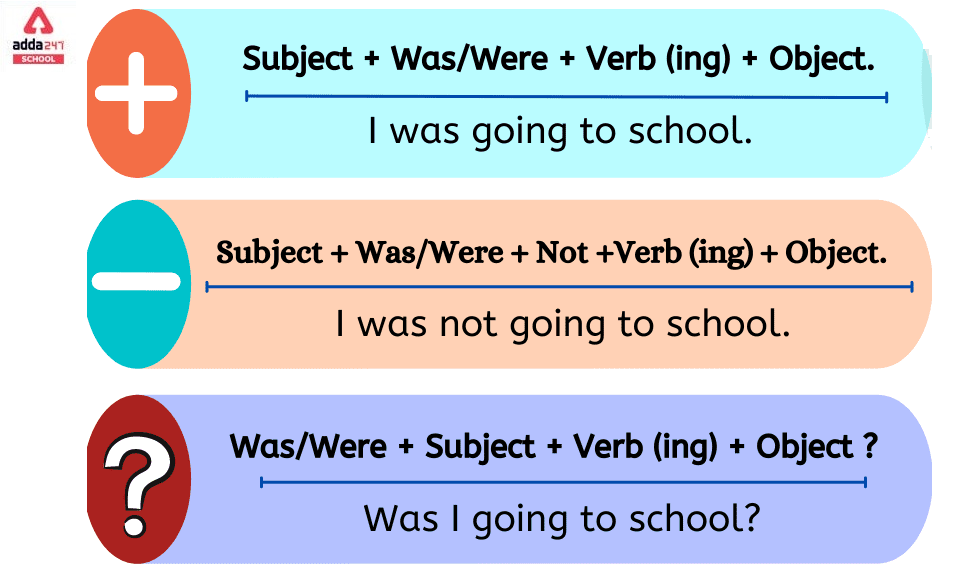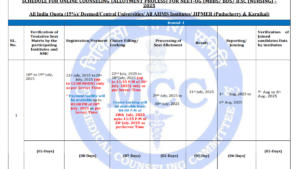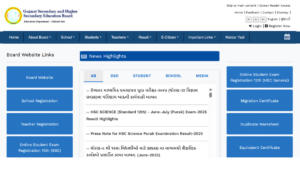When discussing events that occurred at a certain point in the past or over a prolonged length of time, the past continuous form of tense is employed. It is constructed with the present participle of the main verb and the auxiliary verb “to be” in the past tense (was/were). Using the past continuous form of tense, we can explain activities or occurrences that were underway at a particular time in the past.
Past Continuous Tense (Progressive Tense)
The Past continuous form of tense, as the name suggests, is a form of tense used to express actions that were ongoing or taking place at some moment in past. It is also known as the past progressive tense because it represents an action going on in the past tense. Now let’s look at the definitions provided in various dictionaries for the past tense.
To prepare up to the mark for class 10 Join the
Past Continuous Tense Definition
The definitions of the past continuous form of tense according to standard dictionaries are as follows:
The Cambridge Dictionary defines it as “the grammatical form used for an action that someone was doing or an event that was happening at a particular time.”
The Macmillan Dictionary describes it as “the tense used to talk about actions or behavior that were begun and ended at some time in the past.”
The Collins Dictionary defines it as “a verb form consisting of an auxiliary be in the past tense followed by a present participle and used to indicate that an action or event was incomplete or in progress at a point of reference in the past, as ‘were going’ in They were going to the market.”
Past Continuous Tense Formula
The formula for the present continuous form of tense is given below.
| Subject + was/were + present participle (verb+ing) + the rest of the sentence |
However, there are other things to be aware of. You should also learn how sentences are constructed using the past tense of verbs when the verbs are positive, negative, interrogative, and negative interrogative.
Past Continuous Tense Structure
Look at the table below to get a better understanding of the structure of the present tense.
| Positive | Negative | Interrogative | Negative Interrogative |
| Subject + was/were + present participle (verb+ing) + the rest of the sentence | Subject + was/were +not+present participle (verb+ing) + the rest of the sentence | Was/were + subject + present participle (verb+ing) + the rest of the sentence? | Was/were+ subject + not+ present participle (verb+ing) + the rest of the sentence?(or)
Wasn’t/weren’t + subject + present participle (verb+ing) + the rest of the sentence? |
Examples
|
Examples
|
Examples
|
Examples
|
Past Continuous Tense Uses Rule
Past Continuous form of Tense also called past progressive tense, is used to describe an action/event that took place at a particular time in the past.
- Use to interrupt Action in the Past
Use the past continuous to indicate that a longer action in the past was interrupted. Interruptions are usually short actions in the past tense.
Note that this may be an actual mess or just a time mess.
For examples:
- I was watching television when she called me.
- She was completing her work when her mother came back.
- Children were playing in the park. it started raining.
2. Repetition of events with Always
For examples:
- Rohan was always coming to class late.
- He was constantly speaking. He annoyed everyone.
- I didn’t like my relatives because they were always complaining.
3. Use to define parallel Actions
For examples:
- I was learning while he was making dinner.
- While Annie was reading, Kim was watching television.
- Were you listening while they were talking?
Past Continuous Tense Rules
Rules to be used while writing in the past progressive tense.
- Use the helping verb appropriately. With third person singular and ‘I’ ‘was’ will be used, with a plural noun or pronoun ‘were’ will be used.
- Add ‘-ing’ in the main action verb.
Past Continuous Tense Examples Sentences
Here are some examples of Past Continuous form of Tense for the better understanding of students
- Children were going to school. (Positive)
- Children were not going to school. (Negative)
- Were children going to school? (Interrogative)
- Weren’t children going to school? (Negative interrogative)
- The boys were playing in the park. (Positive)
- The boys were not playing in the park. (Negative)
- Were the boys playing in the park? (Interrogative)
- Weren’t the boys playing in the park? (Negative interrogative)
- The baby was crying out loud. (Positive)
- The baby was not crying out loud. (Negative)
- Was the baby crying out loud? (Interrogative)
- Wasn’t the baby crying out loud? (Negative interrogative)
- It was raining then. (Positive)
- It wasn’t raining then. (Negative)
- Was it raining then? (Interrogative)
- Wasn’t it raining then? (Negative interrogative)
- I was cooking pasta for lunch. (Positive)
- I wasn’t cooking pasta for lunch. (Negative)
- Was I cooking pasta for lunch? (Interrogative)
- Wasn’t I cooking pasta for lunch? (Negative interrogative)
- Miss Peters was teaching in the class. (Positive)
- Miss Peters wasn’t teaching in the class. (Negative)
- Was Miss Peters teaching in the class? (Interrogative)
- Wasn’t Miss Peters teaching in the class? (Negative interrogative)
Past Continuous Tense Exercises
After looking at all the examples given, you should have a really good idea of the past continuous form of tense. Here is the exercise given below for a better understanding of the concepts:
Q. Fill in the blanks using the correct form of the verb given in the bracket:
- Janet …………………….. a special dish for her family. (cook)
2. I …………………………… them to complete the work on time. (expect)
3. The students ………………………… a poem on the stage. (recite)
4. The old man ……………………………. on his bed. (sleep)
5. The children ……………………………… sand castles on the beach. (make)
6. The birds ………………………………. on the trees.(sing)
7. The children ……………………………… mangoes. (pick)
8. I …………………………….. a portrait of a lady. (draw)
9. She ……………………….. French. (learn)
10. The kids …………………………. fruits. (eat)
Check your answers
- Janet was cooking a special dish for her family. (cook)
2. I was expecting them to complete the work on time. (expect)
3. The students were reciting a poem on the stage. (recite)
4. The old man was sleeping on his bed. (sleep)
5. The children were making sand castles on the beach. (make)
6. The birds were singing on the trees. (sing)
7. The children were picking mangoes. (pick)
8. I was drawing a portrait of a lady. (draw)
9. She was learning French. (learn)
10. The kids were eating fruits. (eat)
Past Continuous Tense in Hindi
भूतकाल निरंतर काल, जैसा कि नाम से पता चलता है, काल का एक रूप है जिसका उपयोग उन क्रियाओं को व्यक्त करने के लिए किया जाता है जो अतीत में किसी क्षण में चल रही थीं या हो रही थीं। इसे भूतकाल के प्रगतिशील काल के रूप में भी जाना जाता है क्योंकि यह भूत काल में चल रही एक क्रिया का प्रतिनिधित्व करता है। आइए अब भूतकाल के लिए विभिन्न शब्दकोशों में दी गई परिभाषाओं को देखें।
विगत सतत काल – सूत्र
विषय + था/थे + वर्तमान कृदंत (क्रिया+आईएनजी) + शेष वाक्य
हालांकि, इसके बारे में जागरूक होने के लिए अन्य चीजें हैं। आपको यह भी सीखना चाहिए कि जब क्रिया सकारात्मक, नकारात्मक, प्रश्नवाचक और नकारात्मक प्रश्नवाचक होती है, तो क्रियाओं के भूतकाल का उपयोग करके वाक्यों का निर्माण कैसे किया जाता है।
Present Progressive Tense Examples in Hindi
बेहतर समझ के लिए यहां पास्ट कंटीन्यूअस टेंस के कुछ उदाहरण दिए गए हैं:
बच्चे स्कूल जा रहे थे। (सकारात्मक)
बच्चे स्कूल नहीं जा रहे थे। (नकारात्मक)
क्या बच्चे स्कूल जा रहे थे? (पूछताछ)
क्या बच्चे स्कूल नहीं जा रहे थे? (नकारात्मक पूछताछ)
लड़के पार्क में खेल रहे थे। (सकारात्मक)
लड़के पार्क में नहीं खेल रहे थे। (नकारात्मक)
क्या लड़के पार्क में खेल रहे थे? (पूछताछ)
क्या लड़के पार्क में नहीं खेल रहे थे? (नकारात्मक पूछताछ)
बच्चा जोर-जोर से रो रहा था। (सकारात्मक)
बच्चा जोर से नहीं रो रहा था। (नकारात्मक)
क्या बच्चा जोर-जोर से रो रहा था? (पूछताछ)
क्या बच्चा ज़ोर ज़ोर से नहीं रो रहा था? (नकारात्मक पूछताछ)
तब बारिश हो रही थी। (सकारात्मक)
तब बारिश नहीं हो रही थी। (नकारात्मक)
क्या तब बारिश हो रही थी? (पूछताछ)
क्या तब बारिश नहीं हो रही थी? (नकारात्मक पूछताछ)
मैं दोपहर के भोजन के लिए पास्ता बना रहा था। (सकारात्मक)
मैं दोपहर के भोजन के लिए पास्ता नहीं बना रहा था। (नकारात्मक)
क्या मैं दोपहर के भोजन के लिए पास्ता पका रहा था? (पूछताछ)
क्या मैं दोपहर के भोजन के लिए पास्ता नहीं बना रहा था? (नकारात्मक पूछताछ)
मिस पीटर्स कक्षा में पढ़ा रही थीं। (सकारात्मक)
मिस पीटर्स कक्षा में पढ़ा नहीं रही थी। (नकारात्मक)
क्या मिस पीटर्स कक्षा में पढ़ा रही थीं? (पूछताछ)
क्या मिस पीटर्स कक्षा में नहीं पढ़ा रही थीं? (नकारात्मक पूछताछ)
Related Articles:
- Present Perfect Continuous Tense: Examples, Formula, Sentences, Exercises, Rules
- Present Continuous Tense: Examples, Exercises, Formula, Rules
- Simple Present/Indefinite Tense- Examples, Exercises, Rules, Sentences, Formula
Past Progressive Tense QNAs
Q.1 What is the past continuous form of tense with examples?
Ans. As the name suggests, it is a form of tense used to express actions that were ongoing or taking place at some moment in past. It is also known as the past progressive tense because it represents an action going on in the past tense.
Examples: She was cooking dinner.
Q.2 What are the four types of past progressive tense?
Ans. The four types of Past Progressive Tense are as follows
Positive, Negative, Interrogative, and Negative interrogative.
Q.3 When past continuous is used?
Ans. Past Progressive Tense also called past progressive tense, is used to describe actions that were ongoing in the past.
Q.4 What is the structure of the past progressive tense?
Ans. The structure of the past progressive tense is
| Subject + was/were + present participle (verb+ing) + the rest of the sentence |
Q.5 What are 5 examples of past progressive tense?
Ans. 5 examples of Past Progressive Tense are given below:
Boys were playing in the park.
Children were making noise in the class.
My mother was cooking dinner.
Miss Peters wasn’t teaching in the class.
Wasn’t I cooking pasta for lunch?
I hope you have understood the topic clearly. Stay updated!









 NEET UG 2025 Counselling Dates OUT! Chec...
NEET UG 2025 Counselling Dates OUT! Chec...
 Dr MGR Medical University Results 2025 R...
Dr MGR Medical University Results 2025 R...
 GSEB HSC Science Supply Result 2025 Down...
GSEB HSC Science Supply Result 2025 Down...









